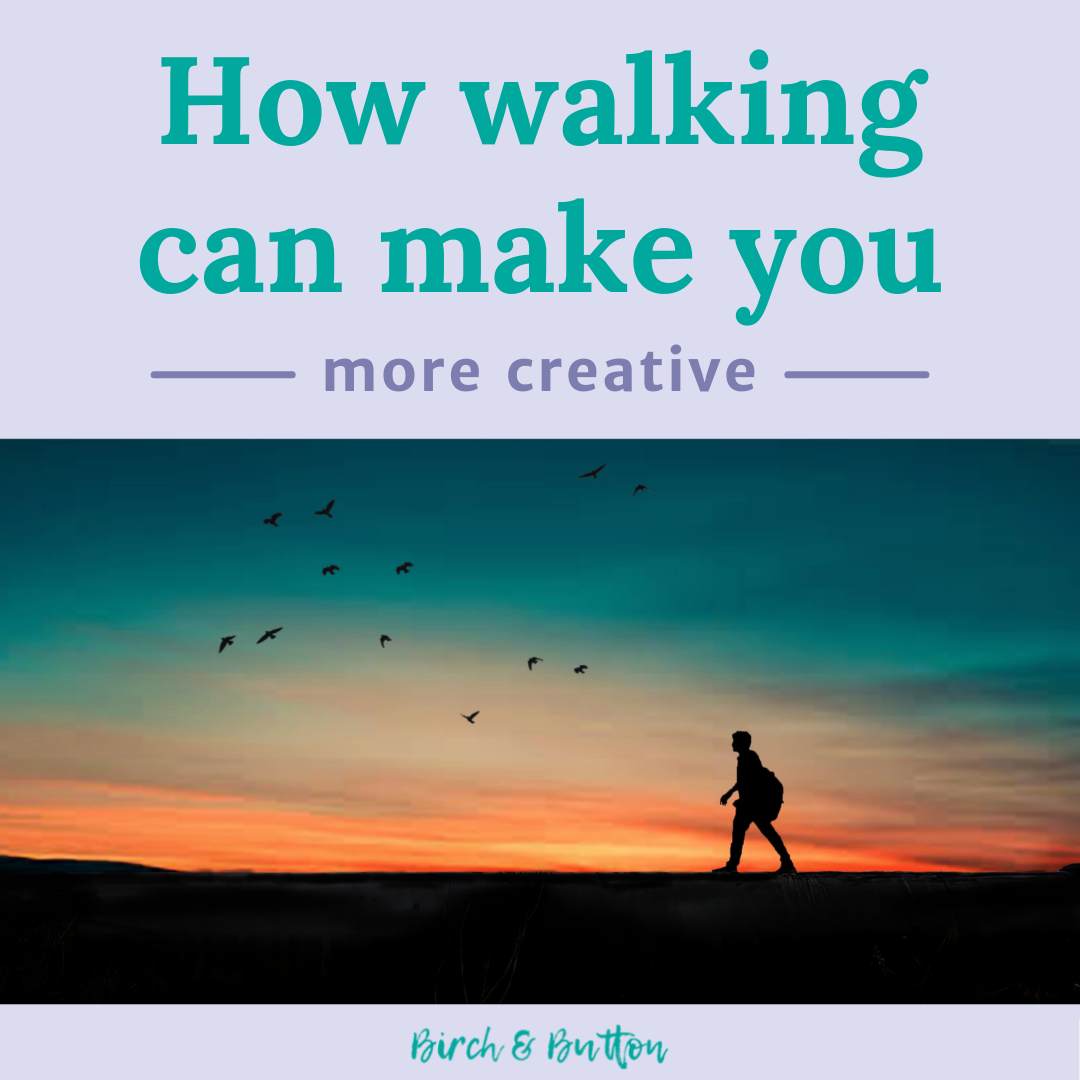Everyone has those moments when they’re looking at something they’re painting, drawing, or making and feeling completely stuck. But did you know a study has found that walking can make you more creative? Read on to find out more.
Have you read my blog post 14 Ways To Find Creative Inspiration? If you have, you’ll know one of the ways I suggest to kickstart your creativity is to take a walk.
Interestingly, I hadn’t come across the study I’m going to talk about today when I wrote that article. I just knew that going for a walk seemed to get the ideas moving again when I’m stuck creatively. I didn’t know why or how — I just knew it worked.
And I can’t remember why or how I discovered it. But when I did, it was like something just clicked into place. It wasn’t just a coincidence that my creativity seemed enhanced when I was walking.
Sign up for my monthly emails of creative tips, tutorials and DIYs and get 31 free creative prompts!

You can unsubscribe at any time
Others who believe in the creative power of walking
I’m not the only one who feels like this. The philosopher Friedrich Nietzsche said, “All truly great thoughts are conceived by walking”.
And besides Nietzsche, others to have made the most of the creative power of walking are Mark Zuckerberg, Steve Jobs and Charles Darwin.
Darwin maintained a strict schedule when he was working on ‘On the Origin of Species’, with a work day that started and ended with walking.
He would take a short walk every morning when he woke at 7am. He would then eat breakfast and head to his study for an hour and a half of work. Then followed an hour reading letters, then another hour and a half of work.
By this point it was noon. He would then spend as much of the afternoon as he felt necessary walking a specific route around his property and thinking about any particularly challenging ideas.
When he was satisfied that he’d made some progress on these issues, he’d consider his work day finished.
How does walking increase creativity?
It seems Darwin may well have realised the effect of walking on his creativity. And many years later, researchers at Stanford University found that a person’s capacity to think creatively increases by up to 60% while they’re walking. The effects also last for a short while afterwards.
In the study, groups of people walked both outside and on a treadmill indoors. Both groups had a much higher creative output than those who were sitting in the same locations.
So you could go for a walk around the block, or just pace around your living room. It doesn’t matter where the walking happens. It’s the actual act of walking that causes the increase in creativity.
Obviously, being outdoors has its own benefits, and you’d probably prefer to be walking through some lovely countryside or on a beach.

Taking a walk around your local streets is just as beneficial, although the study suggests walking in a location with as few distractions as possible to maximise the positive effects.
The study found that general brainstorming sessions may well be more effective when carried out on foot. But if you’re trying to figure out the specific answer to a particular problem or question, walking probably won’t help. So while walking helps the creative process of generating ideas or broader concepts, the same can’t be said for focused thinking.
The exact reason why walking helps to make you more creative isn’t quite clear. But the researchers are confident that the results from this study will no doubt lead to more work on the subject.
Other mental benefits of walking
It’s long been known that exercise has positive effects on brain processes, such as helping to maintain memory and helping to boost concentration.
A 2008 paper in the journal ‘Psychological Science’ outlined an experiment in which researchers asked two groups of people to carry out a task requiring a lot of concentration (they were told a series of digits and asked to repeat them backwards).
Before doing the task, one group was asked to take a walk in the city centre, while the other walked through a wooded path in the nearby arboretum. The group that walked in nature performed the task up to 20% better than the other group.
This held true when they repeated the experiment the following week, but with the groups’ walking locations switched. It wasn’t the people that made a difference but the location where they walked.
This is one of many studies that backs up Attention Restoration Theory (ART), which states that not only is time spent in nature enjoyable, but it can help improve focus and concentration. And studies have also found that just looking at scenes of natural landscapes can provide this positive boost.
ART looks at ‘directed attention’, which you need to concentrate effectively. You only have so much directed attention, so when it’s used up, you’ll struggle to concentrate. Even walking through a city uses directed attention, as those taking part in the study concentrated on how to get around safely and navigate the crowds.
When the participants were walking in nature, they were surrounded by what the researchers called ‘inherently fascinating stimuli’ that occupy and stimulate the mind without it needing to actively pay attention. This in turn helped the participants recharge their supply of directed attention, preparing them for the concentration task.

Some physical benefits of walking
Besides the mental benefits, exercise is obviously vital for a healthy body. Walking briskly can help build stamina, burn calories and make your heart healthier. And if we’re honest, many of us probably don’t move as much or as often as we should.
But don’t think it’s only long walks that count. The NHS says that even 10 minutes of brisk walking each day has lots of health benefits and can count towards your recommended 150 minutes of exercise each week.
Walking can also reduce your risk of developing certain health conditions, including cardiovascular diseases such as high blood pressure and stroke, type 2 diabetes and some cancers, according to Bupa.
Walking can even help to curb a sweet tooth! Just 15 minutes of walking can reduce chocolate cravings, according to findings from the University of Exeter. Walking can also help you eat less chocolate in stressful situations. And this can only be a good thing for those of us inclined to turn to sugar for comfort…
So make the most of your creative block and use it as an opportunity to go for a walk – a boost in creativity is just one of the positives!
Have you tried walking when you have a creative block? If not, would you give it a go after reading this article?
About Stacey

I’m Stacey and I’m a blogger, abstract artist and freelance writer. My aim is to help busy people feel inspired and get more creative with tutorials, hints and tips.
I live in Cardiff with my partner and dog, and in my free time you’ll find me hiking, reading, painting or sampling a craft beer or two.

